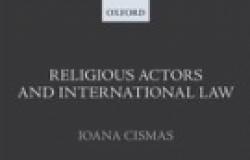Book Review: Religious Actors and International Law

Religious Actors and International Law by Ioana Cismas. Oxford: Oxford University Press 2014. 384 pp, £70 hardcover 978-0-19-871282-4
Much of the literature on religion, international law, and human rights has focused on the question of the (in)compatibility of international human rights with religion(s). Ioana Cismas asks us to shift our attention: from religions to religious actors, and to view these actors in light of their rights and responsibilities in international law. She rejects the exceptionalism of religious actors in international law and the denials of responsibility issued by religious actors when faced with evidence of human rights violations. Instead, she presents a persuasive case for holding these actors accountable to international human rights standards.
For Cismas, religious actors come in different shapes and sizes: individuals, non-state organizations (including both non-violent and violent groups), states, and intergovernmental organizations who interpret religious texts and speak on behalf of God. These actors often claim special international legal status because of what they consider their unique role as the interpreter of God’s word. Problematically, they benefit from the rights and protections provided by international law, but then they sometimes deny their responsibilities to protect human rights and even in some cases undermine the rights framework. Cismas agrees that religious actors have legitimacy claims different from other actors: unlike most other international actors whose legitimacy claims rest on legal-rational authority, religious actors’ legitimacy claims rest on tradition and charisma. Still, she argues, these actors have an international-legal personality and should be held accountable for their responsibilities.
Cismas’ three case studies are also important: churches under the jurisdiction of European Convention on Human Rights (ECHR), the Holy See-Vatican, and the Organization of Islamic Cooperation (OIC). First, in order to illustrate non-state religious actors under international law, Cismas examines ECHR jurisprudence developed by the now-defunct European Commission on Human Rights and by the European Court of Human Rights (ECtHR). Cismas finds that ECHR jurisprudence grants religious and secular actors similar rights and responsibilities with one major difference: religious actors can claim additional rights articulated in Article 9—rights to freedom of thought, conscience, and religion. For Cismas, the existence of these additional rights does not invalidate the essential equality of religious and secular non-state actors under international law. This is because the ECtHR recognizes the rights of religious actors to freedom of religion as an extension of the individual right to freedom of religion that is manifested collectively, rather than a corporate right. Cismas observes that although ECHR jurisprudence protects the autonomy of religious entities from excessive state intervention, this autonomy does not trump individual rights. The court has acted delicately in balancing the autonomy of religious entities and the rights of individuals. The evolution of this jurisprudence, according to Cismas, confirms that the ECtHR recognizes “religious organizations as rights-holders and duty-bearers under the ECHR” (p. 307).
Next Cismas discusses the Holy See-Vatican. She makes a persuasive case for viewing the Holy see-Vatican as single international-legal personality. She notes that the legal personhood attached to this entity has confused many because the Holy See-Vatican rests on two sources of international legitimacy: the customary recognition of the Holy See and its religious claim and, second, the international legal legitimacy provided to the state-like construct of the Holy See-Vatican as a result of the Lateran Treaty (1929). Sidestepping this debate—if this entity is a “state” under Montevideo Convention criteria (territory, population, government, and international recognition)—she argues that the “Holy See-Vatican state-like construct” should be held accountable as a state under international law. She contends that the Holy See-Vatican was intentionally vague about its own identity because the ambiguity surrounding its quasi-state status allowed it to benefit from international recognition but to avoid responsibilities, in particular with regard to international human rights. A related issue is the way in which the Holy See-Vatican has used this ambiguity and the principle of sovereign immunity to avoid charges against the Catholic Church in domestic courts, in places such as the United States, Ireland, and the Philippines. Cismas argues that, given the extraterritorial reach of the church, the Holy See cannot conduct itself as a regular actor in other states (buying land, providing religious services, establishing education institutions) and then claim to be beyond the jurisdiction of the domestic courts in these states.
Finally, Cismas examines the Organization of Islamic Cooperation—the only inter-governmental organization with a strong religious character. She exclusively focuses on the OIC’s engagement with international human rights. She describes the ambiguous structure of the OIC as something between a regional and “religionist” organization. This complexity is also evident in the OIC’s engagement with international human rights. International legal provisions grant it access to the UN and legitimize its own human rights standards, monitoring protocols, and enforcement mechanisms for the purpose of a “context-sensitive application of universal human rights.” As a “religionist” organization, the OIC espouses radical cultural relativism arguments by subsuming human rights under sharia (Islamic law), thereby creating a loophole that lets OIC member states escape from their international human rights responsibilities. Cismas examines the OIC’s human rights instruments in detail and finds them questionable from the perspective of universal human rights, for they create an alternative human rights framework incompatible with international human rights. She claims that OIC is an international actor benefiting from international law and thus should be held accountable under international law.
The case studies nicely support Cismas’ argument that international law is all-encompassing: international religious actors enjoy similar rights to their secular counterparts and thus should be held accountable similarly. They cannot selectively claim their relevancy and rights in international law when it suits their purposes and at the same time deny the reach of international law when it comes to their responsibilities.
Although I am convinced we should focus more on religious actors rather than religions, I do not think that international law, human rights law, the UN, or ECtHR treat all religious actors as well religious and secular actors equally. My own studies suggest that non-Christian actors, and Muslims in particular, face more scrutiny in the international public sphere, where Islam and its symbols are commonly identified with extremism. Cismas’s treating of “religious actors” as a category does not allow her to examine if these actors face a varied international legal landscape depending on the religious traditions they represent.
This book, a product based on the author’s dissertation, could have been edited better. It is wordy, and filled with jargon, cross-references, and direct quotes. Many non-English expressions could have been easily stated in English. Rather than a direct quote in the original language and footnotes with author’s own translation— introduced inconsistently as “this author’s,” “author’s,” and “own” translation—the author could have provided her own translation in the text, saving the reader from going back and forth between the text and the footnotes frequently.
Overall, this book is a welcome and refreshing addition to the growing literature on religion and human rights. Human rights activists, diplomats, and scholars would benefit from paying more attention to religious actors and the ways to hold them accountable to international human rights law, rather than engaging in exegetical debates with them on the right way to interpret religious texts.
Turan Kayaoglu is Associate Professor and Associate Dean of Faculty in the School of Interdisciplinary Arts and Sciences at the University of Washington Tacoma.

